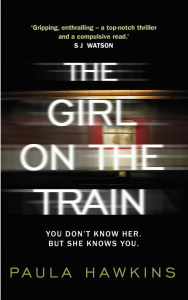
Sometimes a negative review entices me to read a book. To be fair though, in the case of Paula Hawkins’ The Girl on the Train, there were also a fair amount of positive reviews that made me want to read it. What I didn’t expect was that I would like it so much. I basically gobbled it down in a couple of sittings. For sure, the writing is very simple—present tense + short sentences + split narrative, short chapters, three narrators. Not exactly sophisticated writing. And, yes, the three women who tell this story have only one voice. Without chapter headings indicating when it’s Rachel’s, Megan’s or Anne’s turn to tell the story, we would hardly be able to guess. Their lives are different, some of their dysfunctions are different, but the tone and vocabulary is pretty much the same. And all three of them are not exactly role models.
There’s Rachel, the girl on the train. Every day she commutes to London, guzzling cans of pre-mixed gin and tonic, although she’s been unemployed for some time. The train always stops at the same place and she gets a good view of one of the houses. The young good-looking couple living there fascinates her. They remind her of herself and her ex-husband Tom with whom she used to live only a few houses farther down. While her obsessive interest in the couple is strange, it is far stranger that she’s willing to enter her fantasy world when she thinks she sees something shocking. I’m not going to write more as it’s a book that’s easily spoilt.
Why did I love it, you wonder? There are books that do nothing more than exploit an idea or an image. In this case: looking at people from a train and imagining their lives. I liked this idea a great deal. I would never spy on people with binoculars – a habit I find positively disgusting-, but I’m fascinated by the tiny glimpses of other people’s lives we can catch when we are on a train. I often wonder what kind of life they have, those people, frozen in a single moment of their lives, while I rush by. I could relate to Rachel’s fascination and understood how someone as dysfunctional and lonely would get caught up in her fantasies.
I also loved the novel because I found it very gripping. And very realistic. I’ve had the misfortune of meeting a Megan and an Anna. Also women like Rachel, only without her alcohol problems. One of the characters in particular reminded me of a girl I used to work with for a while. The moment a guy showed interest in someone else, had a girl friend or a wife, she had to fling herself at him.
The Girl on the Train is a page-turner that depicts certain aspects of our society like isolation, commuting, envy, and narcissism in a realistic way. It’s a bit like Gone Girl’s little sister, although the writing isn’t nearly as good. Still, if you’re in the mood to gobble down a book and share my fascination with the small glimpses of other people’s lives you can catch while rushing by on a train – get it. It’s flawed but entertaining. Just one word of warning – the end is a bit disappointing.
After finishing it I picked up Renée Knights Disclaimer and was amused to see that the sticker on the book doesn’t say “The new Gone Girl” but “If You Liked The Girl on the Train“. I suspect in a few months it will say “The new Disclaimer“. I’m eager to find out which I will like better.
